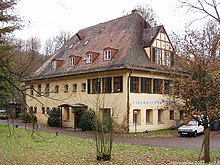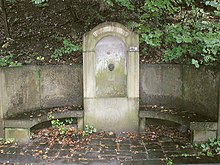Jägerhaus (Heilbronn)
The hunter's house in the area of the independent city of Heilbronn ( Baden-Württemberg ) was originally built in 1678 as the home of one of the city hunters. The origins of the restaurant in the building go back to around 1760, when the town hunter at that time began serving wine and beer to visitors.
Geographical location
The Jägerhaus is located 3.6 km east- south- east of Heilbronn city center and 1.2 km (depending on the beeline ) southeast above the Trappensee in the Heilbronn mountains . In the Heilbronn city forest , it is located near the southern edge of the reed sand quarry nature reserve at the Jägerhaus with the surrounding area in the vicinity of the Waldheim . The district road 9550 (Heilbronn- Donnbronn ) leads past .
History and description
In 1413 a hermitage was built in the city forest near today's Jägerhaus, and in 1460 the "stone pit" is mentioned for the first time. In 1678 the hunter's house was built next to an oak that was 150 years old at the time as the home of one of the two city hunters (the other hunter lived in Böllinger Hof). Around 1740 the house had to be thoroughly renovated because it was dilapidated.
Around the same time as the tower keeper on the nearby Wartberg , town hunter Simon Hager began serving wine and beer to visitors to the Jägerhaus around 1760. In 1762 the building was expanded to include a guest room for the then Heilbronn councilor Georg Christoph Kornacher , who requested a room for hunting purposes and to visit the quarry. The mining of the Heilbronn reed sandstone shaped the face of the landscape surrounding the hunter's house, so huge spoil heaps can still be seen today. From 1777 to 1782, today's Jägerhaussteige was built as a removal route for the stones extracted from the nearby quarry, at the same time the Jägerhaus also developed into a popular excursion destination, so that in 1787/88 the builder Johann Christoph Keller carried out another renovation of the Jägerhaus, which is now was also a dance and event venue.
When Heilbronn came to Württemberg in 1803, the lease of the town hunter at that time also ended, and in the following years the house was only a restaurant. A new hall was built in 1833, and in the same year the King of Württemberg was a guest.
On August 29, 1837, the roof of the Jägerhaus burned down and the damage could be repaired by December of the same year. During a renovation in 1862 by city architect Koch, the hipped roof was replaced by a flat gable roof and the nearby hermitage was demolished. The hunter's room , which has been preserved to this day, also dates from this time . Towards the end of the 19th century, the Heilbronn Beautification Association laid out around 1000 meters of winding promenade paths on the spoil heaps around the hunter's house that had already been partially planted by forest inspector Bernhard Nickel . In 1954, the road leading past the Jägerhaus was relocated somewhat, so that it was led around at a greater distance from the 500-year-old Jägerhaus oak that had not yet been felled .
In 1954, the hunting lodge was designed by the Municipal Building Department during his conversion forms ( hipped roof , segmented arch - roof houses , Baroque-style window bars and art nouveau-like interiors), which are traditionally oriented and from the country house architecture of the home style originate. The entrance door on the east side of the Heilbronner Jägerhaus is emphasized by handcraft and shows a program of images related to the function of the Jägerhaus. The building is adorned with a "rich repertoire of figurative representations from the flora and fauna of the Heilbronn city forest as well as from the world of hunting".
On May 3, 2016, the Heilbronn municipal council decided to sell the municipal property on which the Jägerhaus stands to Wolfgang Scheidtweiler (owner of Palmbräu ).
The Jägerhaus serves as the starting point for the walk to the forest heath in the southeast and to the former sand reed quarry north of the restaurant.
literature
- Rolf Rau: The Heilbronn city forest and its educational trail (= small series of publications from the Heilbronn archive. Volume 5). Heilbronn City Archives, Heilbronn 1970.
- Helmut Schmolz, Hubert Weckbach: Heilbronn. The old city in words and pictures. Volume 2. Konrad-Verlag, Heilbronn 1967, No. 56.
- Uwe Jacobi: Heilbronn as it was. Droste, Düsseldorf 1987, ISBN 3-7700-0746-8 .
Individual evidence
- ↑ A. Groninger: Philipp Jakob Nast, the first host on the Wartberg . In: Swabia and Franconia. Local history supplement of the Heilbronn voice . 3rd year, no. 3 . Heilbronner Voice publishing house, March 30, 1957, ZDB -ID 128017-X .
- ^ Helmut Schmolz, Hubert Weckbach: Heilbronn. The old city in words and pictures. Volume 2. Konrad-Verlag, Heilbronn 1967, No. 56, p. 38.
- ^ Julius Fekete: Art and cultural monuments in the city and district of Heilbronn. Theiss, Stuttgart 1991, ISBN 3-8062-0556-6 , p. 49.
- ^ Julius Fekete , Simon Haag, Adelheid Hanke, Daniela Naumann: Stadtkreis Heilbronn . (= Monument topography Federal Republic of Germany , cultural monuments in Baden-Württemberg, Volume I.5.). Theiss, Stuttgart 2007, ISBN 978-3-8062-1988-3 , pp. 58-59, 101-102 .
- ^ Joachim Friedl: Jägerhaus is sold. The Pforzheim entrepreneur and brewery owner (Palmbräu) Wolfgang Scheidtweiler takes over the traditional restaurant. In: Heilbronn voice . May 3, 2016 ( Stimme.de [accessed May 3, 2016]).
Web links
Coordinates: 49 ° 7 '57.4 " N , 9 ° 16' 0.7" E


